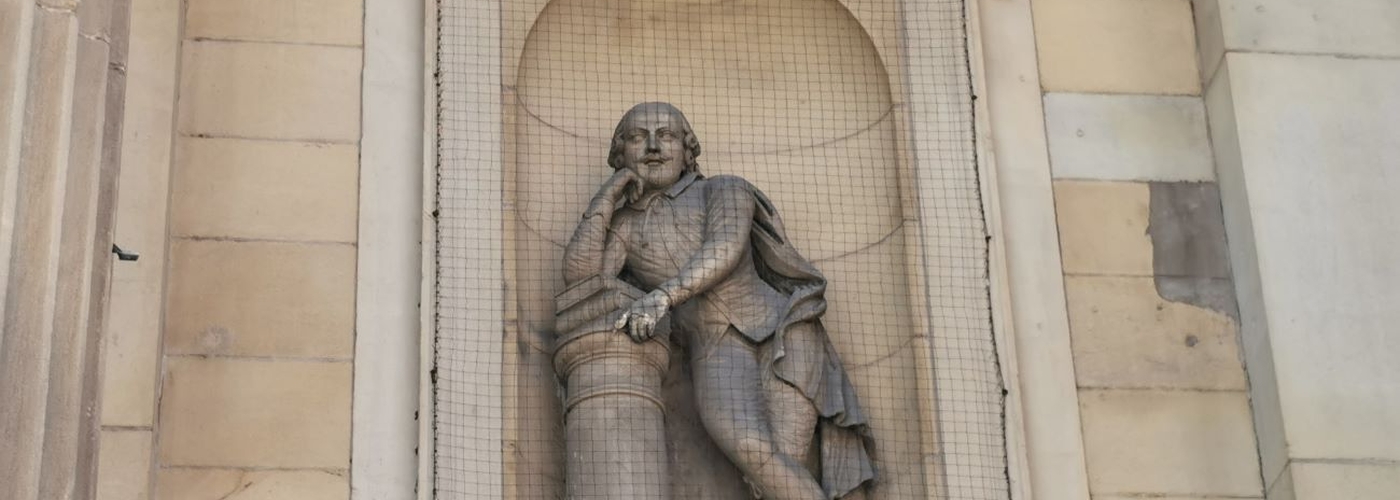Gladstone's extra finger, a camp Shakespeare and mad signwriting... Jonathan Schofield reveals strange details often missed
5 minute read
MANCHESTER has a lot of the weird and the wonderful about it. Often though, this is easy to miss. So here’s a guide to four curiosities that can be found in the south west corner of the city. Over time we’ll reveal more in other areas of the city centre and beyond. This article has been rewritten from one six years ago.
William Gladstone’s extra finger
As a young man, William Gladstone went hunting and bagged his own finger. While reloading his gun, the future four times British prime minister (between the years 1868 and 1894) shot off his left forefinger. After the incident he would wear a glove to disguise the injury. Everybody knew about the missing digit but, politely, nobody mentioned it.
The Liberal politician, a Scouser by birth, was adored in Manchester, a famously Liberal city. Following his death a public subscription quickly raised funds and a sculptor, Mario Raggi, was employed to provide a suitable statue. It was erected in 1901 and purported to show Gladstone at the dispatch box in Parliament. It also gave him back his missing finger permanently. It was only kind to do so, but also perhaps Raggi realised that if he had delivered an accurate portrayal of the hand then, as the years passed and memory faded, passers-by might think he was a rubbish artist who couldn't even count, 'that hand’s only got three fingers and a thumb'.
Manchester buildings suffer a set-back
In 1945 Manchester made a plan to essentially demolish the whole city centre and start again. Only a few buildings would remain: the Cathedral, Chetham’s, Central Library and the Midland Hotel. The rest, including the Town Hall, would have to go. They were too old-fashioned, too tarnished by an industrial and imperial past for the intellectuals of the post-war world. Time for a fresh start, time to wipe the slate clean.
In the end such drastic action was unaffordable and increasingly undesirable. Some elements of the plan survived though, one being to widen Manchester city centre’s streets. Thus buildings in the fifties and sixties were set back from the street, the idea being that when the whole street was redeveloped it would have a new building line and a grander, wider profile. Of course whole streets weren’t redeveloped, so as you can see from this picture, the sixties building hosting Brewdog is set back from the Edwardian building hosting Albert’s Schloss. It’s a fun game spotting these post-war attempts at re-invention. Well, fun for me.
Daft William, the Ugly Bard of Peter Street
We should be proud. We have the worst (and campest) statue of William Shakespeare in the world. This is displayed on the 1845 Theatre Royal building on Peter Street. The head’s too big for the weedy body and legs just don’t work like that. The story goes that John Knowles, the impresario who created the theatre, also owned a marble and stone works down the road, where Churchgate House presently stands. Supposedly Knowles decided to get one of the masons to knock out a statue of the Bard, and it turned out laughable. A satirical poem was penned over a century and a half ago when the statue was revealed.
Old ‘Rare Ben Johnson’ came to town,
And from Bank Top soon hurried down,
Determined Deansgate first to see,
(For Ben at all times loved a spree.)
As down through Peter Street he passed,
By chance an eye he upward cast,
And saw above the playhouse door,
A face like one he’d seen before;
Then thought as he advanced more near,
‘Twas Shakespeare’s, his old crony dear,
‘Pray who are you are, perched there so high?’
The statue answered with a sigh,
‘They say I’m Shakespeare, what think you?’
‘Why, if you are, your case looks blue,
You’ve got a club foot, now I see,
And a white-swelling in your knee
And dropsied legs, and such a phiz,
You must be there for folks to quiz’.
More maladroit theatre drama (sack the painter)
The Opera House began life as the New Theatre in 1912. It’s got a grand Classical style facade with details including a splendid bas-relief of god-like figures, horses and a chariot which was called ‘The Dawn of the Heroic Age’ by John Tanner & Sons.
On two altar-like motifs, the names of famous dramatists are displayed. The one on the west side mentions our two friends from above, Shakespeare and Jonson. There’s Marlowe as well, their contemporary, and Sheridan, the author of The Rivals, the first play performed at the Royal Exchange.
But who is the other person...ah, yes Mr Vawblsh. Who the hell is Vawblsh? It seems the person who repainted these names didn’t know his drama, so instead of the 18th century playwright Sir John Vanbrugh, we get the never ever written a play or even existed gent, Mr Vawbish.
Read next: Mundane Magic: Oxford Road, River Medlock and a Frenchman
Read again: Maggie's Grand Costume Ball, March 2023 - What inspired the city's biggest Fancy Dress Ball?
Get the latest news to your inbox
Get the latest food & drink news and exclusive offers by email by signing up to our mailing list. This is one of the ways that Confidentials remains free to our readers and by signing up you help support our high quality, impartial and knowledgable writers. Thank you!

















